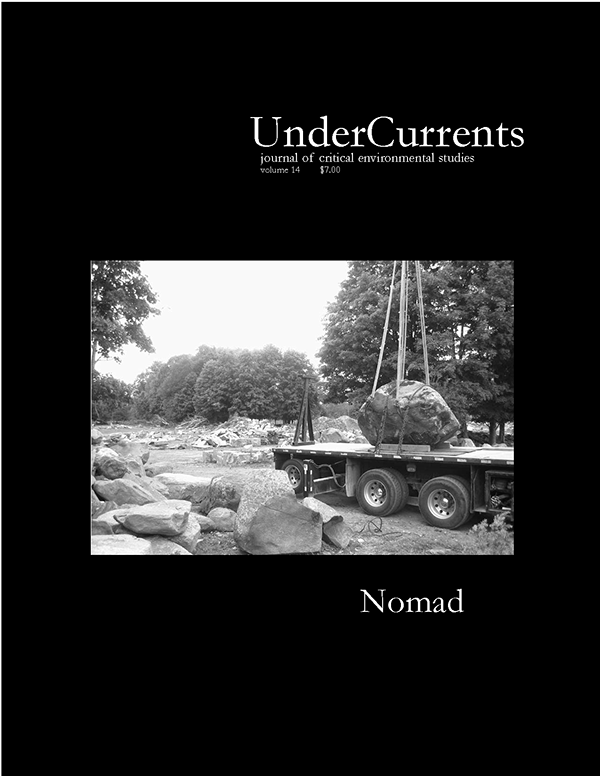Embodied Motion in the Modern Metropolis
DOI:
https://doi.org/10.25071/2292-4736/40410Abstract
The modern city – the metropolis – is a site of movement. It is a place of exchange and transfer, of people, vehicles, materials and information, which ebb and flow through its infrastructure. The increasingly mobile dynamics and the use of transient and tensile urban forms, indicate the origins of a distinctly ‘nomadic’ experience of the metropolis.
References
Baiocchi, Gianpaolo. 2002. The Pariahs of the Wonderful City: fear and the imagined geography of citizenship in Rio de Janeiro, Brazil, 1977-1982.” DisClosure: A Journal of Social Theory 11.
Barke, Michael, Tony Escasany and Greg O’Hare. 2001. Samba: A Metaphor for Rio’s Favelas? Cities. 18 (4): 259-270. DOI: https://doi.org/10.1016/S0264-2751(01)00018-X
Beesley, Philip. 2004. Skin Deep: Liminal States. Catalogue essay for Skin Deep, Thames Gallery, Chatham & Gallery Stratford, Ontario.
Baudelaire, Charles. 1986. The Painter of Modern Life and Other Essays. New York: DaCapo Press.
Brown, Carol. 2002. Dancing in the Mediascape: Intersections between dance, architecture and technology. On Tour: British Drama and Dance. 19: 10-13, http://www.britishcouncil.org/on_tour_issue_19_pdf. (accessed March 04, 2005)
Capoeira, Nestor. 2002. Capoeira: Roots of the Dance-Fight-Game. Berkeley: North Atlantic Books.
Christo and Jeanne-Claude. 2005. “The Gates: Central Park, New York, 1979-2005,” Christo and Jeanne-Claude Web Site, http://www.christojeanneclaude.net/tg.html. (accessed March 05, 2005)
Deleuze, Gilles and Félix Guattari. 1987. A Thousand Plateaus: Capitalism and Schizophrenia. Translated by Brian Massumi. Minneapolis: University of Minnesota Press.
Featherstone, Mike. 1995. Undoing Culture: Globalization, Postmodernism and Identity. London: Sage.
Gans, Deborah and Zehra Kuz. 2003. The Organic Approach to Architecture. Chichester, West Sussex: Wiley-Academy.
Kronenburg, Robert. 1996. Portable Architecture. Oxford: Architectural Press.
Kronenburg, Robert, ed. 1997. FTL. Todd Dalland and Nicholas Goldsmith: Softness, Movement and Light. Architectural Monographs No 48. Chichester, West Sussex: Academy Editions.
Leach, Neil, ed. 1994. Rethinking Architecture: a reader in cultural theory. Routledge: London.
Lewis, J. Lowell. 1995. Anthropologies of the Body: Genre and Embodiment: From Brazilian Capoeira to the Ethnology of Human Movement. Cultural Anthropology. 10 (2):221-243. DOI: https://doi.org/10.1525/can.1995.10.2.02a00040
Meirelles, Fernando. 2002. “Director’s Statement.” City of God. http://cidadededeus.globo.com/ (accessed March 05, 2005)
Mooney, Jake. “As the Transitory Leaves Town, the Ethereal Fills the Void.” New York Times, March 06, 2005.
O’Hare, Greg and Michael Barke. 2002. The favelas of Rio de Janeiro: A temporal and spatial analysis. GeoJournal 56: 225-240. DOI: https://doi.org/10.1023/A:1025134625932
Oliveira, Ney dos Santos. 1996. Favelas and Ghettos. Race and Class in Rio de Janeiro and New York City. Latin American Perspectives. 23(4): 71-89. DOI: https://doi.org/10.1177/0094582X9602300406
Pollock, Griselda. 1988. Vision and Difference: Femininity, Feminism, and Histories of Art. London: Routledge.
Published
How to Cite
Issue
Section
License
Copyright (c) 2005 Jay WorthingCreators retain copyright for all writings and artwork published in UnderCurrents. New material published as of Volume 21 (2022) is available under a Creative Commons Attribution 4.0 International License (CC-BY 4.0).


